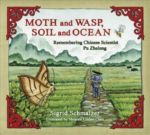
A poignant story filled with heart-warming courage as a young girl takes on a harrowing journey to be reunited with her mother.
Historical Fiction genre

A poignant story filled with heart-warming courage as a young girl takes on a harrowing journey to be reunited with her mother.

Liberated from Bergen-Belsen Concentration Camp in 1945, sixteen-year-old Gerta tries to make a new life for herself, aided by Lev, a fellow survivor, and Michah, who helps Jews reach Palestine.

Moth and Wasp, Soil and Ocean tells its story through the memories of a farm boy who, inspired by Pu Zhelong, became a scientist himself.

In this unforgettable multicultural coming-of-age narrative—based on the author’s childhood in the 1960s—a young Cuban-Jewish immigrant girl is adjusting to her new life in New York City when her American dream is suddenly derailed. Ruthie’s plight will intrigue readers, and her powerful story of strength and resilience, full of color, light, and poignancy, will stay with them for a long time.

The first-person narrative portrays Lorraine’s family and community with realistically drawn personalities and relationships as well as fine-tuned ethical dilemmas, while sketching in the backdrop of the wider catastrophe. A moving personal story.

A young outcast is swept up into a thrilling and perilous medieval treasure hunt in this literary page-turner by acclaimed bestselling author Catherine Gilbert Murdock.

Follows Dita Kraus from age fourteen, when she is put in charge of a few forbidden books at Auschwitz concentration camp, through the end of World War II and beyond. Based on a true story.
Featured in Volume XI, Issue 4 of WOW Review.

The year is 1299. Fourteen year-old Elenor reluctanly awaits the return of her betrothed — a man she hardly knows — from the Crusade. Thomas, broken and disillusioned from years of fighting, finds the very idea of marriage and lordship overwhelming. So When the village priest sends them on religious pilgrimage before the marriage, both are relieved.

A fictionalized retelling of the childhood of Mary Anning, one of the world’s greatest fossilists.

Having fled the rampaging revolutionaries in Mexico in 1911, thirteen-year-old Evangelina and her family face unexpected prejudice and violence in Texas.